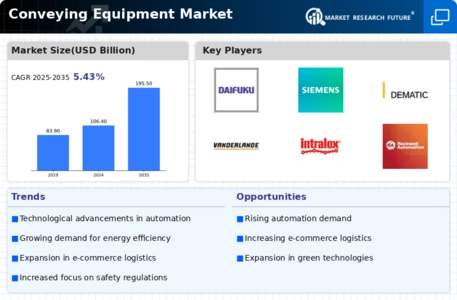Expansion of E-commerce
The rapid expansion of the e-commerce sector plays a pivotal role in driving the Global Conveying Equipment Market Industry. With online shopping becoming increasingly prevalent, logistics and distribution centers are under pressure to enhance their operational efficiency. This has led to a greater reliance on sophisticated conveying systems to manage the high volume of goods being processed. For example, major e-commerce players are investing in automated sorting and conveying technologies to ensure timely deliveries. As a result, the market is expected to witness robust growth, with projections indicating a rise to 195.5 USD Billion by 2035, reflecting the industry's adaptation to evolving consumer behaviors.
Sustainability Initiatives
Sustainability initiatives are increasingly influencing the Global Conveying Equipment Market Industry, as companies prioritize eco-friendly practices in their operations. The demand for energy-efficient and recyclable conveying systems is on the rise, driven by regulatory pressures and consumer preferences for sustainable products. For instance, manufacturers are developing conveyors that utilize less energy and are made from recyclable materials, aligning with global sustainability goals. This shift not only enhances corporate responsibility but also opens new market opportunities. As industries adopt greener practices, the market is likely to benefit from increased investments in sustainable conveying solutions, further propelling its growth.
Technological Advancements
Technological advancements significantly influence the Global Conveying Equipment Market Industry, as innovations in materials and design enhance the performance and efficiency of conveying systems. The introduction of smart conveyors equipped with sensors and IoT capabilities allows for real-time monitoring and predictive maintenance, reducing downtime and operational costs. These advancements are particularly relevant in sectors such as food and beverage, where hygiene and efficiency are paramount. The market's growth trajectory, with a projected CAGR of 5.69% from 2025 to 2035, suggests that ongoing technological developments will continue to shape the landscape of conveying equipment, driving further investments in the sector.
Rising Demand for Automation
The Global Conveying Equipment Market Industry experiences a notable surge in demand for automation across various sectors, including manufacturing and logistics. Automation enhances efficiency and reduces labor costs, prompting industries to invest in advanced conveying systems. For instance, automated conveyor belts and systems are increasingly utilized in warehouses to streamline operations. This shift towards automation is projected to contribute significantly to the market's growth, with the industry expected to reach 106.4 USD Billion in 2024. As companies seek to optimize their supply chains, the adoption of automated conveying equipment is likely to accelerate, reflecting a broader trend towards Industry 4.0.
Market Trends and Projections
Growth in Manufacturing Sector
The growth in the manufacturing sector is a key driver of the Global Conveying Equipment Market Industry, as increased production activities necessitate efficient material handling solutions. Industries such as automotive, electronics, and consumer goods are expanding their operations, leading to a higher demand for conveying systems that facilitate the movement of materials and products. For example, automotive manufacturers are implementing advanced conveyor systems to optimize assembly lines and improve productivity. This trend is expected to sustain the market's upward trajectory, contributing to the overall growth forecast, with the industry anticipated to reach 106.4 USD Billion in 2024.


















